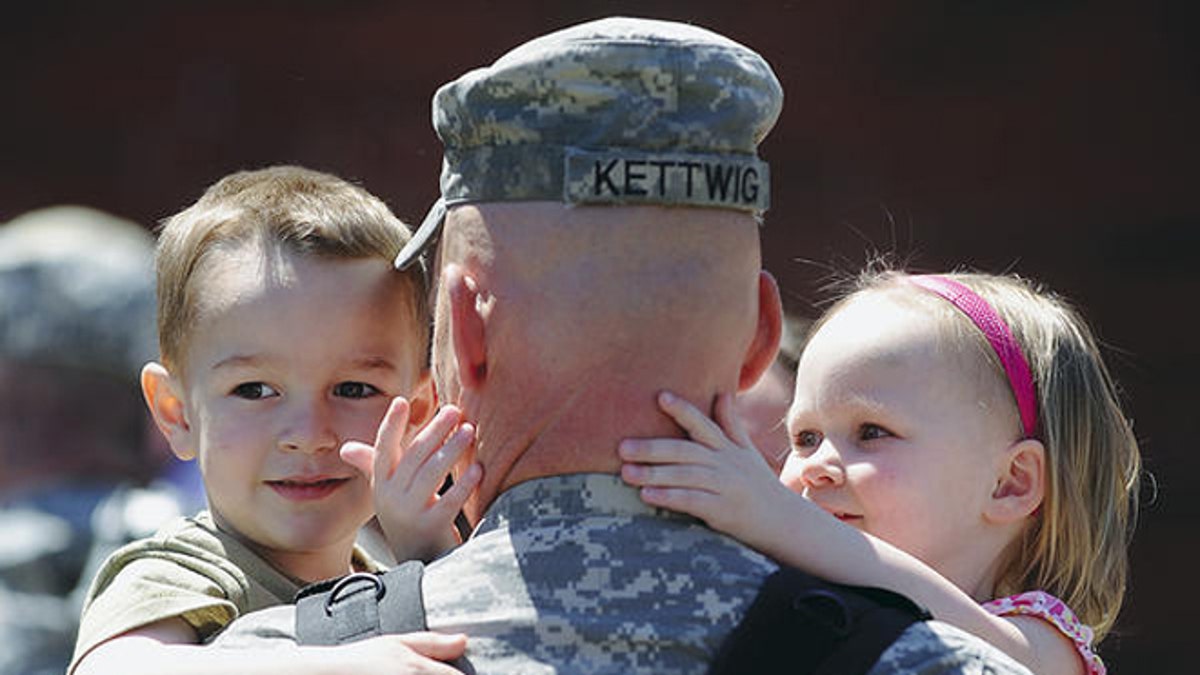
2011: Maj. Jason Kettwig of Milbank, S.D., greeted his children at a Sioux Falls, S.D., homecoming on May 3. (Elisha Page/Argus Leader/AP)
Whether a service member is separating after four years, retiring after 20 years, being forced to discharge, or separating due to injury or illness, transition can be a difficult time for many veterans and their families. No two individuals experience the same situation, and not all problems can be averted.
The White House and Department of Defense have in recent months overhauled how military personnel separate from the military seeking a way to make the transition an effective and positive experience. The Veterans Administration and US Department of Labor have actively been seeking answers to the rise in the number of unemployed veterans, which has reached 12.1 percent of the nation's unemployed.
Among those transitioning, it is estimated that 30,000 to 300,000 veterans will be affected by the invisible wounds of war (i.e., PTSD and other related mental disorders, including traumatic brain injury) as a result of the U.S. engagement on the Global War on Terrorism. Even for those veterans who are not suffering from the aftermath of combat experiences – keeping in mind that many veterans do not have PTSD – there is a veteran mindset that is influenced by military culture, which could present challenges in terms of reintegrating into civilian society.
Transition from military to civilian life can be a daunting task, and for many people it’s a confusing time. For some service members, separation from the military can be an overwhelming personal experience, create financial hardship, and contribute to the already challenged family system. A successful transition can be accomplished by helping the service member clarify their personal and professional goals as well as identify their plans for achieving those goals.
[pullquote]
Individuals who are undergoing separation from the military have been known to experience a variety of feelings, including: anxiety, frustration, fear, and loss. At times individuals can also question the meaning and purpose of their lives.
A strategy for combating these difficult feelings is through the provision of education and information. For instance, information on how to secure civilian jobs, including what skills are transferable from military to civilian employment, are helpful to those transitioning. Information on how to find adequate housing and ways to get back into a civilian lifestyle can also assist the service member in their transition.
One way for veterans to get involved in the community is to participate in their child’s education or by volunteering or joining a religious organization which can further help to create a sense of community and cohesiveness.
In the case where a veteran does not have a child, and prefers to not become religiously affiliated, there are still other options for the veteran to build community connections.
Discovering new interests, tapping into old interests, learning new hobbies, and even joining a community sports team can be extremely beneficial. These activities not only get the service member involved in the community, but the activities also serve as a way to bring meaning into an individual’s life.
To improve the transition process from active duty service to civilian employment, there are several recommendations that military personnel should consider.
1) The service member should not wait until 30 days from separation or retirement before starting the military to civilian transition process.
2) Seeking out the services of agencies such as the VA, county-operated veteran services, and traditional veterans service organizations can be extremely helpful to those veterans who are seeking to transition from the military.
3) The service members should make certain prior to separation to research key certifications and go after them while they are still in the service.
4) Getting assistance from a sponsor, mentor, or a job coach on how to translate the military skills into civilian language and terminology is also helpful.
5) Attending career fairs for military veterans and seeking out recruiting firms that specialize in placing military veterans is also recommended. Additionally exploring all employment options, such as federal, state, and civilian opportunities is a good idea; this includes not settling for the first job that comes along that may not be a good fit.
Finally, it is my belief that the responsibilities of assisting veterans succeed is not the sole responsibility of the VA or DOD and should be the responsibility of all of us. We need the creativity of all community agencies for-profit and non-profits alike. We have a duty and obligation to serve those who served our country.




















